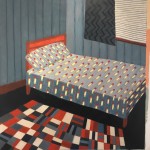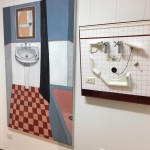
To Sleep On – acrylic on canvas 167 x 152cm
“Cities, like dreams, are made of hopes and fears”
– Italo Calvino – The Invisible Cities
At Chrissie Cotter Gallery, between the urban vegie garden and the tennis courts and opposite
typical inner Sydney terrace houses, four artists present their exhibition ‘Inhabited Architecture’.
Through their varied disciplines which include drawing, assemblage, painting and installation, with
humour, the grotesque and perhaps beauty, they explore the representation of memory, emotion,
and family tensions in relation to houses they imagine. Lived experiences are replaced by dream
worlds; haptic memory is reconstructed from routine; the material world expresses hidden desires
and secret histories. The bones that are architectural drawings take on a life of their own. The
exhibition spills out into the street where a parked caravan encloses someone’s fantasy world. All
the works reflect on different ways that houses hint at unseen occupants and their lives.
Artist Statement
Susan O’Doherty
My paintings and mixed media assemblages relate to our interior physical and mental living spaces and to patterns of behaviour, both literal and metaphorical. Our daily lives can be summed up by the state of the family home, with our inclination for order and presentation a cheerful veneer camouflaging human failings and unpredictable events. We are constantly bombarded with violent images, distressing news and a flood of social media.
These works are about universal anxieties, filtered through the depiction of our intimate and domestic environments. The paintings and assemblages are not just about four walls, or material spaces. No people appear in the works, only personal effects, the iconography of our lives. I’ve used a mix of contemporary and vintage implements, found objects selected for their use, colour, age and histories; plastic, glass, ceramics, textiles and metals which have been carefully placed to convey a narrative. But things aren’t always as they appear; at closer viewing something ominous may intrude, a knife or gun floating over the picture plane. In some of the works the motif of the gun is the dominant image. Pistols and rifles represent a sense of threat and menace present in our world, at a distance and up close.
I’ve composed these works with painted wallpapers, bedspreads, tablecloths, tiled floors, patterned carpets and curtains with a strong colour palette to reinforce the idea of beautiful living spaces, to draw the viewer into the room. There is a bed to lie on, a chair to sit on, a cup to hold, a knife and fork, a mix master to bake a cake; objects to trigger recollections and memories of childhood and family experiences.
Essay by Victoria Hynes
“Cities, like dreams, are made of hopes and fears”
—Italo Calvino, The invisible Cities.
The right to housing is both a basic human need and a fundamental birthright. The home has long been seen as a place of refuge and protection, a safe harbour in which we can shelter from some of the outside world’s harsh realities. Yet, behind closed doors this idyll is often far removed from reality.
At Chrissie Cotter Gallery, nestled between a thriving urban veggie garden and rows of century old terrace houses, four female artists explore the social, political and economic complexities of the domestic sphere. A suite of draughtsman’s drawings hang alongside delicate furnishings created out of molded paper; alluring assemblages of vintage crockery are ensconced next to cluttered Barbie doll dens. Each artist investigates the private interior space as a source of desire and memory, fantasy and drudgery, joy and loss, love and fear.
Susan O’Doherty, Freya Jobbins, Ro Murray and Mandy Burgess are all Sydney based artists who work with mixed media. They have each created their own physical space within the gallery, filled with assemblages, sculptures and collages. The spaces are not occupied, but the human presence is strongly felt through the domestic iconography on display.
O’Doherty’s assemblages, paintings and free standing sculptures are as palatable to the eye as a clipping from ‘Home Beautiful’ magazine. Against modernist patterns of soft furnishings – vibrant wallpaper, bedspread, tablecloth and floor tile designs – sit harmonious arrangements of gleaming kitchen implements. Tea and sugar canisters, milk bottles, tea cups and egg beaters float alongside discarded ‘feminine’ items such as lingerie and evening bags, as well as the odd children’s shoe. A dismembered hand from a department store mannequin rests elegantly upon a table, sporting a perfect set of fire engine red nails. A pair of shiny black pumps are scattered amidst rolling pins, upturned Schweppes bottles, baby rattles and an empty ashtray. These initially appear like reliquaries to home-spun bliss, until your eye is drawn to the other items fixed within the composition. Skillfully placed within this cosy homage to domesticity are sharpened knives and hammers, pistols and razors. Open scissors are splayed on the floor; handguns are placed inside delicate ceramic vases in place of flowers. Overtones of domestic violence are everywhere in her carefully arranged compositions. Looking beneath her utilitarian objects of quotidian routine are allusions to volatility and danger, both in the outside world and within the home. O’Doherty highlights the variance between our public and private worlds; in her idealised environments, household order is often a veneer masking emotional tensions and unresolved conflicts.
Freya Jobbins sources her supplies from op shops and garage sales, however you’d likely find her rummaging through the toy section rather than kitchenware. Jobbins has built up a popular following through her elaborate assemblages created entirely from abandoned plastic dolls. Hundreds of dismembered Barbie’s and Bratz dolls are transmuted into playful sculptures, that are based on the paintings of sixteenth century artist Giuseppe Arcimboldo, who composed ornate portraits entirely out of fruit, vegetables and flowers.
The sculptural heads and humanoid forms that Jobbins creates out of these broken toys are deliberately grotesque and provocative. At times reminiscent of Patricia Piccinini’s human hybrids; one piece features a pristine white crib housing a freakish baby composed entirely of plastic body parts. Raiding forlorn toy boxes all over Sydney, Jobbins’ art practice borders on the obsessive and fetishistic, yet her work has a serious intent. She refers to her practice as ‘upcycling’; the process of collecting long discarded childrens items to draw attention to the amount of over-consumption and rampant consumerism that is taking over societies in the First World. This throwaway culture quickly disposes of the last assembly line of toys once a new fad is produced. Jobbins’ anarchic installations present both a children’s insatiable fantasy land and a social critique of contemporary capitalism that is as sharp and pointed as it is mischievous.
Artist Ro Murray directly draws upon her former life as an architect to inform her current conceptual art practice. She transforms her ‘dead-filed’ architectural plans, overlaying them with bold lino prints in red and black. Using a combination of organic and geometric shapes, they harken back to the stark utilitarian designs of the Constructivist art movement from the early 1900s. The works hang like ethereal banners in the gallery space, fluttering on a long line of pegs. Although their meaning is elusive, they could be making reference to the transitional nature of housing and how easily this security can be lost in the current social and economic climate.
Mandy Burgess also addresses the transient nature of the home through the very physical medium of her papermaking. Burgess creates sculptural objects out of paper pulp based on domestic interiors. Hand made doors and fireplaces seem to gradually dissolve and slowly disintegrate. The sculptures refer to the home as a site of impermanence and decay. The sculptures are as intangible as memories; like ghostly effigies of homes lived in ones past or in ones imagination. Demonstrating the tenuous nature of the home and hearth, the artist implies that material security is often wafer thin. The ‘happy home’ is often as flimsy as a paper facade.
The public face versus the private realm is a thread interlinking all the works on display. As Burgess states, it is: “the tidy façade versus the chaos inside. The clipped nature strip versus the grimy bath. The calm and responsible demeanour which hides the slipping-out-of-control and panic of the heart.”
Each of these four artists presents us with a particularly ‘female’ take on the interior space. Historically seen as a feminine domain, these artists overturn such traditions and present us instead with complex inner worlds. Meticulously crafted and easily accessible, these powerful works help us view the interior space in a new light. The exhibition is both visually compelling and politically charged, the artworks operating like a smoking gun hidden in one of Susan O’Doherty’s dainty satin evening purses. . . .























